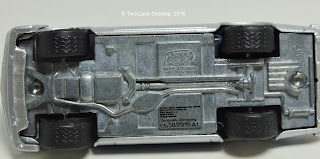Johnny Lightning 1972 Chevy Vega wagon and 1980 Chevy Monza Spyder
Chevrolet Vega's are not known for being reliable, yet that doesn't stop replica's of the car from appearing left and right. This was more noticeable 10 years ago when Motormax released the Fresh Cherries line that included the Vega. Then other diecast manufacturers have created their own, including Hot Wheels V8 powered Vega. These two shown here are the nice clean examples from Johnny Lightning that have not seen much use after their introduction to the Tomy period, but now they get a second chance.
Click for Photo Gallery
The Vega was the replacement for the ill-fated Corvair (which was also popular again by collectors) as a new compact, fuel-efficient car just in time for the 1970's oil embargo's. The new compact cars shared much with the new 1970 Camaro's styling and offered a practical interior in body styles that range from coupe to a wagon. The first powertrain was a new all-aluminum SOHC 2.3L I-4 that produced 110 horsepower through a 4-speed manual or two-speed automatic transmission. Suspension consisted of front control arms and live rear axle with leaf springs. Soon after problems started to emerge as the 4-cylinder lacked proper cooling and metal sleeves, causing the aluminum block to melt and in turn oil leaks to show up. Another problem related to those living in the rust belt was the rapidly rusting out body panels. Even after GM fixed these problems the Vega's image, like the Corvair's, was tarnised. However, a new lease on life appeared in 1974 when the sleekly-styled Monza coupe appeared. The wedge-shaped coupe was vastly different in looks than the Vega yet it still shares the same platform underneath. Originally this car was supposed to run the new Wankel motor, but instead it got the same engine as the Vega, then upgrated to the new 2.5L Iron Duke I-4 that produced 90 horsepower through a 4-speed manual or two-speed automatic transmission. The 2+2 was nicknamed "The Italian Vega" in its resembalance to the Ferrari 365 Daytona coupe. Despite the success of the Monza it still shared some of the Vega's ill effects and went out with the Vega after 1980 to make room for a new family of GM compact cars.
Click for Photo Gallery
It's nice to see the wagon and Monza Spyder back in the line and look even better than before. I was unimpressed by the fastback Vega that first appeared with a small-block V8 under the hood and too high of a stance. The wagon fixes those issues with a more stock look. The Vintage Green color is gorgeous on this wagon and the chrome rally wheels from a 1975 Corvette look right on this car. The front has round headlights with large grille split by a chrome bumper and lower signal lights. The side profile shows a stock wagon appearance with lower black trim and chrome trim. There's even ribbed vents on the rear fender. The rear has rectangular taillights, a nifty liftgate badge, and a license plate that is also the base tab support. The metal base shows off the typical drivetrain and suspension layout with nice attention paid to the rear fuel tank area. The forward-opening hood shows off the I-4 motor dipped in orange with detailed air cleaner and valve cover. The interior features seating for four though the rear seat would be very snug for the size of this car. The dashboard layout is very European with a 4-spoke steering wheel, dual pod gauges, and radio controls in the center just above the shifter. Cargo area would be pretty good for this car with the nearly equivalent space of a K-5 Blazer.
Click for Photo Gallery
The Monza on the other hand goes for a more sportier look and nothing says sportier than a silver with blue graphics that say Spider on the sides and have a cool spider detail on the hood stripe. The sleek coupe adds a lower chin spoiler, rear mounted spoiler that wraps around to the rear fenders, and 5-spoke mag wheels in dark gray to add a bit of sportiness despite sharing the same high stance as the Vega Wagon. The front has a sloped nose with quad recessed headlights and lower grille with large signal lights. The sides show a nice and smooth wedge-shape roofline with black window trim accents, while the rear has taillights that connect to a black bar and a neat license plate referencing the spider family. You can see some late '70's Camaro styling influences on the exterior as well. The interior has seating for four with a curved dashboard that conceals twin pod gauges and a radio that stretches out further toward the driver alongside the 3-spoke steering wheel. Even with the fastback roof cargo area does not suffer thanks to the fastback liftgate. Also note the interior has a blue seats wtih a black dashboard to match the exterior decals. The base shows off the same layout as the Vega but with improved suspension tuning and a catalytic converter. Under the hood that opens in normal backwards position shows the Iron Duke I-4 (though it looks a lot like the Vega's 2.3L motor) with additional details given to the black engine. On the track the Wagon was a surprise with great handling dynamics despite the high stance, while the Monza was swifter, but sadly not as fast with the weak motor and saddled to a not-so-sporty automatic transmission.
Click for Photo Gallery
Whether you love them or hate them these are two nicely-done Vega models that represent the actual cars nicely without any additional modifications.
Click for Photo Gallery


































Thank you so much for such an informative piece of information :)
ReplyDeleteIf anyone interested similar one's have a look here
themotorbiker
Thanks